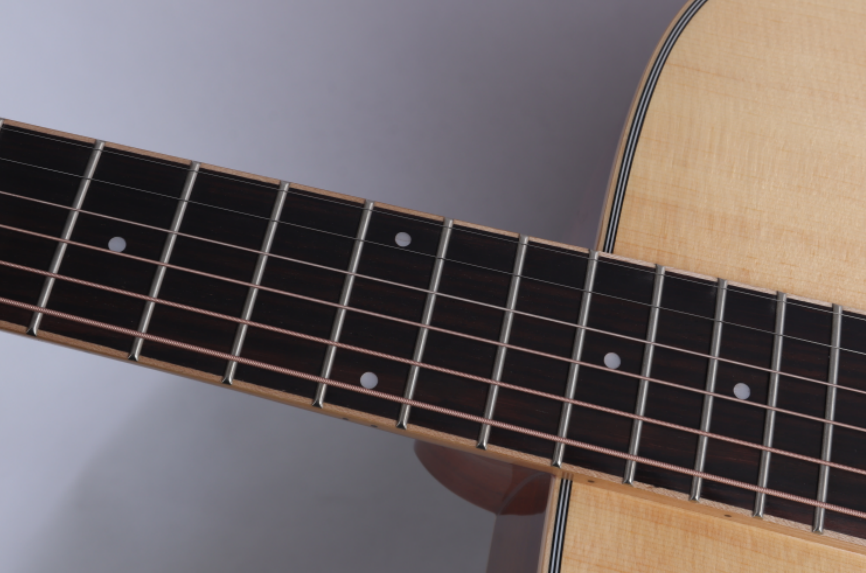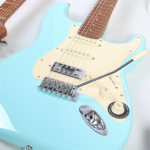
In the guitar production of VEAZEN, even entry-level models like the 300 and 200 series still use rosewood fingerboards and bridges, which have higher costs, instead of some synthetic materials. Why is that?
Rosewood (especially Brazilian rosewood and Indian rosewood) is widely used as a fingerboard material, mainly because its natural properties highly match the functional requirements of guitars. HPL (High-Pressure Laminate), as a synthetic material, is more of a low-cost, high-stability alternative. The differences between the two are reflected in many aspects such as feel, tone, and stability. Here is a detailed analysis:
1. Why is rosewood commonly used for guitar fingerboards?
Rosewood has become the mainstream fingerboard material essentially because of the “compatibility” between its natural attributes and the needs of guitar playing, which can be summarized into three points:
1.1 Feel and playing experience
Rosewood is hard (with a density of about 0.7-0.9g/cm³) but slightly tough. Its surface is smooth and delicate after polishing, and the tiny pores of the natural wood can retain a small amount of oil (such as lemon oil during maintenance), creating a 温润 touch. When pressing the strings, the friction between the fingers and the fingerboard is moderate. It will not cause unstable string pressing due to being too slippery, nor will it affect the fluency of position shifting due to being too rough. It is especially suitable for playing complex fingerings (such as string bending and sliding).
1.2 Vibration transmission and tone assistance
Although the fingerboard is not the core sounding part of the guitar (the soundboard plays a leading role), it will indirectly affect the tone through the transmission of string vibrations. The natural fiber structure of rosewood has the characteristic of “moderate damping”: it will not excessively absorb vibrations (to avoid dry tone) nor excessively reflect vibrations (to avoid harsh tone). It can gently enhance the thickness of the midrange and add warmth to the low end, making the tone more “full”. This characteristic is consistent with the tone orientation of most guitars (especially folk and classical guitars).
1.3 Durability and aesthetics
Rosewood is hard and wear-resistant, able to withstand the pressure of strings and the friction of fingers for a long time, thus having a long service life. In addition, its natural texture (such as black stripes on a dark background) is unique and layered. After painting or oiling, it has an elegant visual effect, which meets the pursuit of “natural aesthetics” for high-end musical instruments.
2. The core advantages of rosewood over HPL
HPL is a synthetic material made by pressing multiple layers of pulp or wood fibers under high temperature and pressure, and its surface is usually printed with imitation wood texture. Compared with HPL, the advantages of rosewood focus on the “experience upgrade brought by natural properties”:
3. Specific effects on tone and stability
3.1 Effects on tone
- Rosewood:
Due to its density and damping characteristics, rosewood can “mildly filter” string vibrations: it suppresses some harsh high-frequency overtones, and at the same time enhances the midrange (200-500Hz) and low end (80-200Hz), making the tone more “warm and mellow”. For example, when a folk guitar is equipped with a rosewood fingerboard, the tone of strumming will be fuller, and the sense of hierarchy of arpeggios will be clearer. - HPL:
As a homogeneous synthetic material, its vibration transmission lacks the “fiber directionality” of natural wood, resulting in low transmission efficiency of string vibration energy. Moreover, the high-frequency overtones (above 2000Hz) decay slowly, which is prone to the problem of “high frequency being too bright but empty”. At the same time, HPL has weak bearing capacity for low frequencies, so the tone is often “thin and dry”, and the dynamic range (the range of changes in volume and tone) is also smaller.
3.2 Effects on stability
- Rosewood:
The stability of natural wood depends on the pre-drying treatment (usually after several years of natural drying + artificial drying, the moisture content is controlled at 6%-8%). If not handled properly, it may shrink (causing the fingerboard to crack) or expand (causing the frets to bulge) due to changes in environmental temperature and humidity (such as humidity below 40% or above 60%). However, high-quality rosewood fingerboards can meet daily use after strict treatment (with proper maintenance, such as regular oiling). - HPL:
As an artificial synthetic material, it has extremely low internal moisture content and a dense structure, so it is almost not affected by changes in temperature and humidity. Its anti-deformation and anti-cracking abilities are far better than those of solid wood without special treatment. This characteristic makes it suitable for use in extreme environments (such as high-humidity areas, stage guitars with frequent transportation), and the maintenance cost is low.
Summary
The core value of rosewood fingerboards lies in the “comprehensive experience brought by natural properties” – from the 温润 feel, rich tone to unique aesthetic value, which makes it the first choice for mid-to-high-end guitars. HPL, on the other hand, has the advantages of “low cost and high stability”, and is more suitable for entry-level guitars or scenarios with high durability requirements. For players pursuing tone and playing texture, the “natural advantages” of rosewood are still irreplaceable by HPL. That is why VEAZEN guitars still choose rosewood with higher cost for many entry-level models in production.

